Ten years ago, a young American schoolgirl received three undeveloped rolls of 35mm film her grandfather took from a German soldier in late April or early May 1945. She took the film to her photography teacher and they developed it, not expecting to find any images. Instead, they found pictures taken by a young Waffen SS recruit during his training.
I was a newspaper reporter writing about this remarkable historical discovery in 1997 and I am renewing my efforts to learn all I can about the pictures. I especially want to know what became of the young men in these pictures.
I want to emphasize that my interest is strictly historical. I have no reason to believe any of these young men were involved in war crimes, nor am I interested in prosecution of war crimes. I believe justice has been served and it is time to move on. Therefore, any sensitive information that comes to me will be held in the highest confidence. In more than 40 years as a professional journalist, I have never betrayed a source, nor will I ever.
German journalists contacted through the Internet have identified city scenes on the films as being taken in Krakow, Poland. This makes it likely that the training scenes were taken at Truppenwirthschaftslager der Waffen-SS Krakau.
The uniforms suggest the pictures were taken before 1942.
I believe they were made by this SS-Schütze (private):
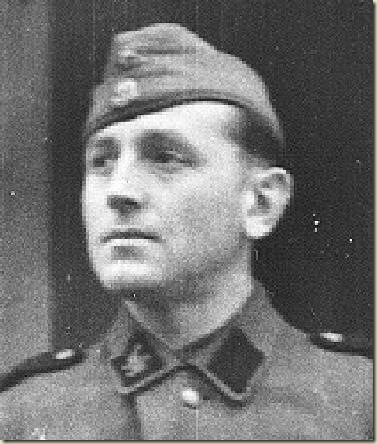
My conclusion is based upon the fact that all of the shots are properly framed and in focus except for the ones of this young man. That's consistent with what happens when you hand your camera to someone who isn't familiar with it and ask them to take your photo.
And this kid with the engaging smile and bad teeth was his friend.
And I believe these are his parents, brother and grandmother.
These would have been his buddies in training.
 Here he is (bottom right) digging entrenchments with other recruits.
Here he is (bottom right) digging entrenchments with other recruits.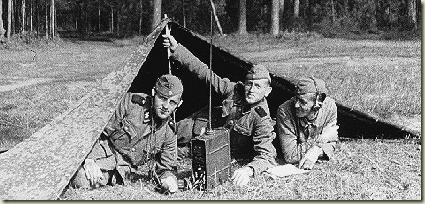 In the center in communications training, possibly learning to be a forward artillery observer.
In the center in communications training, possibly learning to be a forward artillery observer.
Bottom left in a railway car with friends.
Here is the story I wrote in the spring of 1997 when the photos first came to light:
NOBLESVILLE, Ind. – The convergence of an old soldier's souvenirs and his granddaughter's high school photography course has opened a window in time.
Fifty-two springs ago, Ted Brost was a young sergeant in the U.S. Army's military police. He was among hundreds of thousands of Allied troops pouring into Germany to end World War II in Europe.
“I was with the 504th MP Battalion, attached to the Third Army,” recalled Brost, an 81-year-old retired farmer. “We had come up through southern France and up the Rhone Valley and into Germany
“We were right behind the infantry and the Germans were just laying their guns down and waiting for us to come through and move them back to the rear,” he said. “They were finished and ready to quit.”
Brost and his comrades relieved German prisoners of their weapons and anything else of possible military value. In the course of his duties, Brost picked up three 35mm film canisters from a German soldier.
“I don't remember exactly where I got them. I had a trunk with me and, if I picked up anything interesting, I just put it in the trunk,” said Brost, who lives in Benton County.
Brost brought his wartime souvenirs home in September, 1945. The trunk ended up in the closet of an upstairs bedroom of his farmhouse near Boswell. The three film canisters languished there, all but forgotten, nearly half a century.
Recently, Brost said, his wife found the cannisters, suspected they might contain salvageable pictures and gave them to their granddaughter, Melodie Brost.
Melodie, 16, a sophomore at Noblesville High School, took the canisters to her photography teacher Craig Ryan and they examined the find.
Each cannister held a roll of exposed, undeveloped film. Instead of being wound into the kind of 35mm film cassettes familiar to today's photographers, the film was tightly coiled inside the canisters, protected only by the screw-on caps.
Since color photography was in its infancy in the early 1940s, Ryan assumed they were dealing with black-and-white film. He and Brost went into the darkroom and tore off a short strip from one roll for testing purposes and processed it as if it were a medium-speed modern black-and-white film.
“We developed it just to see if the contrast would be okay and it turned out to be great,” Melodie said.
When they pulled the film from the fixer solution they found crisp, well-defined images. Encouraged, they developed the rest of the film with the same chemistry.
Examining the images with a magnifier on a light table, Melodie and Ryan marveled at how well the film held up over a half-century.
“In all their literature, Kodak says to process film within 24 hours, if you can, so it's really amazing to see images this good after so many years,” Ryan said.
Donald “Chip” Maury, director of photography at The Star and The News,was also impressed.
“This is very very unusual,” he said. “What often happens is that film is left there for years, exposed to extreme heat and humidity. In this condition, the film is literally being abused and it causes the latent image to sometimes become fogged or fade off into never-never land. It's kind of a guessing game as to what you're going to get when you process it.”
The film, it turned out, is a photographic record of a young recruit's training in the Waffen-SS.
The SS, short for Schutzstaffel, was created by Adolf Hitler in the 1920s as an elite unit formed around a nucleus of personal bodyguards. Under the leadership of Heinrich Himmler, the SS grew in numbers and influence, taking on police and security duties in the Nazi state and developing a military branch – the Waffen (armed) SS.
The young men in Melodie Brost's pictures were still in their teens, not much older than Melodie. Most, if not all, were the products of years of Nazi indoctrination, beginning as children in the Hitler Youth and continuing with duty in the Reich Labor Service.
Now they were eager, fresh-faced recruits in the SS, training in the summer sunshine. They wore the silver SS lightning bolt runes on their right collar tabs and the characteristic silver SS eagle on the left sleeves of their field-gray wool tunics.
The pictures show a variety of training exercises – stripping and cleaning a machine gun, crossing a river, building a log-and-earth pillbox, operating a field radio and standing sentry duty.
There are scenes of columns of troopers, Mauser rifles on their shoulders, marching across a railroad crossing and down a city street.
The unknown photographer also caught lighter moments. About 40 young enlisted men squint into the slanting rays of what is probably a late afternoon sun, mouths open in song and accompanied by comrades on accordion and washtub bass. Eight recruits pose at the door of a railroad boxcar and a tow-headed blond private beams at the camera, flashing a row of stained teeth.
There are pictures of off-duty SS troopers enjoying themselves in town, posing on the street or crowded happily into a horse-drawn carriage. A few frames show civilians – possibly parents or other relatives.
There are also unexpected images, like pictures of a woolly Bactrian camel, and two shots of a smiling Gypsy woman at the reins of a horse-drawn wagon – an incongruous image, considering that the Nazis targeted Europe's Gypies for extermination along with the Jews.
The pictures are of happy, confident young men, pleased to be in each other's company and oblivious to the horrors of war that lay ahead.
As Hitler's elite, the SS fought with fanatical bravery. But they also handled the most repugnant assignments and were charged with most of the atrocities committed in the name of the Third Reich.
The SS manned the extermination camps of Hitler's “Final Solution.” They methodically rounded up and murdered Jews as German forces pushed into the Soviet Union. It was an SS unit that massacred more than 70 American prisoners at Malmedy during the Battle of the Bulge.
“It's so interesting to think that here, he's having this happy time and then they had this huge war,” Melodie said of the unknown photographer. “They're practicing doing all these things that are kind of fun and they don't look like they realize the seriousness of it all. You wonder what happened right after these pictures were taken.”
The film also includes well-composed pictures of cathedrals, city vistas and pastoral scenes.
“He had a very good eye,” said Ryan. “He really knew how to frame and compose a picture.'”
The unknown photographer might be pleased to know his pictures are being appreciated by a new generation. Melodie mounted several prints made from the negatives and won a merit award with them in a recent art show at school.
Language arts students in Noblesville Intermediate School, studying the Nazi Holocaust, made a field trip to the high school to see the pictures and talk with Melodie and Ryan.
Melodie said she plans to create a photo album of pictures from the long-forgotten film to present to her grandfather.
Unanswered Questions
And Some Deductions
The pictures Melodie Brost rescued raise several questions.
When and where were they made? Who was the photographer? Did he survive the war? Is he still living?
Some of these questions may never be answered, but a few answers have surfaced and much can be deduced from careful examination of the images.
One SS private turns up repeatedly in the photographs– a dark-haired young man of medium build. While most of the pictures on the three rolls of film are artfully framed and in sharp focus, several of the pictures including this young man lack those qualities. It's the kind of pictures you'd expect if you handed your camera to someone unfamiliar with it and asked them to take a picture of you.
One such example is a series of pictures of a family group – possibly the unknown photographer and his parents, grandmother and brother – taken in front of a house.
A group shot, including the man believed to own the camera, is out of focus and off-center. The next frame, however, is razor sharp and shows the same group, minus the man suspected to be the photographer.
In an effort to seek help, some pictures of the suspected photographer and seven urban scenes were posted on an Internet home page. Next, electronic mail messages were sent to about 250 German subscribers of America Online whose user profiles identified them as journalists.
A few hours later, a reply came back from Thomas Krohn, a journalist in Mainz-Kostheim, Germany. The urban scenes, he said, were from Krakow, Poland, and he went on to identify such surviving landmarks at the Cloth Hall in the center of town, the Town Hall Tower, St. Mary's Church and a tower in the medieval wall, where “today, there is a McDonald's next to it.”
The presence of Waffen-SS troops in Krakow would indicate the pictures were taken sometime after the Sept. 1, 1939, German invasion of Poland. The city in southeastern Poland also became the site of a Waffen-SS training camp.
The Germans made Krakow an administrative center and built the infamous Auschwitz death camp 37 miles west of Krakow.
You might conclude these young SS recruits were destined to participate in the murder of an estimated 1.6 million Jews, Gypsies, Russian prisoners of war and others at Auschwitz.
But the troops in Melodie Brost's pictures are training for combat – learning to build bunkers, communicate with field radios and cross rivers. It was another element of the SS – the SS Totenkopfverbande – who staffed the concentration camps.
This is not to say that none of these young men could have transferred to death camp duty or could have committed atrocities. Dr. Josef Mengele, who conducted sadistic and pointless pseudo-medical experiments on Auschwitz prisoners, was a member of the Waffen-SS before he was wounded and considered unfit for combat duty.
Likewise, some Waffen-SS troops were assigned to Special Action Groups, or einsatzgruppen, that followed combat units across Russia, rounding up and executing Jews.
Georg Keppler, former commander of the Das Reich Division of the Waffen-SS, explained after the war that Waffen-SS troops were forced into these einsatzgruppen as a result of disciplinary action.
“They are late or fall asleep on duty. They are court-martialed but are told they can escape punishment by volunteering for the Special Commandos,” he told Allied investigators. “Well, these commandos, where they are first put through special training, are murder commandos. When the young men realize what they are being asked to do and refuse to take part in mass murder, they are told the orders are given as a form of punishment. Either they can obey and take that punishment or they can be shot. In any case their career is over and done with. By such methods decent young men are turned into criminals.”
The few photos showing instructors are of sergeants and corporals with decorations that identify them as wounded combat veterans. The instructors are too young to have earned their wound badges in World War I, leading to the conclusion that they won their decorations during or after the invasion of Poland.
A likely scenario is that the unknown photographer and his comrades were being trained in the summer of 1940 in preparation for the June, 1941, invasion of Russia.
If so, he or a friend carried the undeveloped film for five years before surrendering it to Ted Brost at war's end.
If you know who any of the people in the photos are and what became of them, please contact me here.
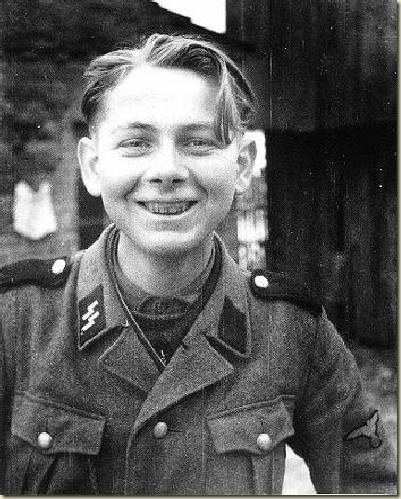
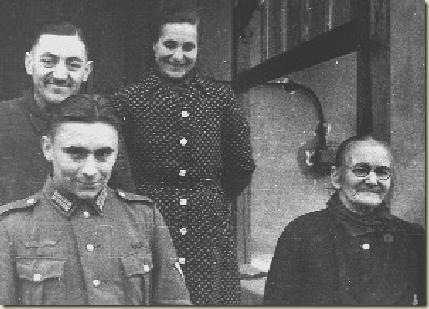
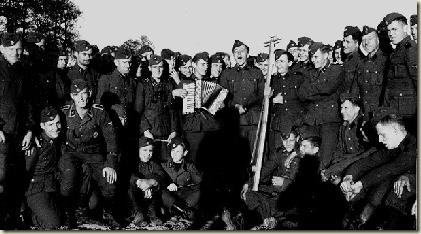
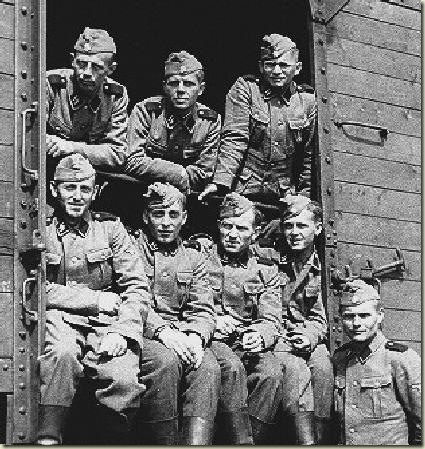
1 comment:
This was a fortunate surprise. I remember working on these photos years ago, but never got very far with them. I do know that some of these photos are certainly post May 1942, because one of the SS NCOs wears a ribbon for the 41-42 Eastern front winter war medal. The fellow who is likely the photographer's brother is also pictured wearing a soft cap that looks like a 1943 field cap, but is more likely a mountain cap (he wears low-cut boots, likely mountain boots and not the ankle boots that appear in 1943). There is one possible way to identify at least the unit, and that's with the license plates on some of the vehicles featured in a few photos. If you had scans at high enough resolution you could get somewhere.
Anyway, thanks for keeping this available, someone may recognize a relative someday.
Post a Comment